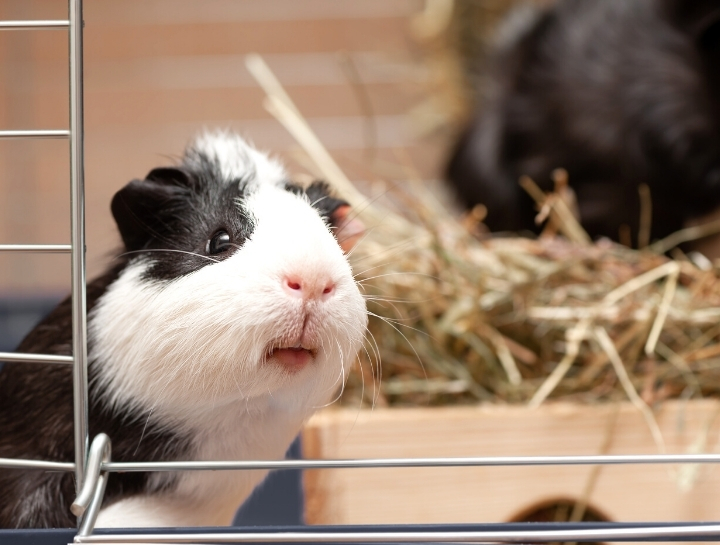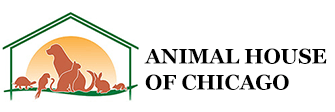Dental Disease in Rabbits, Guinea Pigs, & Chinchillas

Dental disease is one of the most common problems veterinarians see in large rodents and lagomorphs (rabbits and hares). Both the incisors and the cheek teeth (premolars and molars) can be affected. Among the tooth problems these animals face are tooth fractures, maloccluded and overgrown teeth, sharp edges or spikes, infected teeth roots and gums, and tooth root abscesses. Affected teeth can then cause problems, including anorexia and weight loss (too painful or difficult to eat), moist dermatitis from excessive salivation (also called "slobbers"), and gastrointestinal stasis (also called ileus).
Rabbits have 28 teeth total: 6 incisors (4 upper and 2 lower), no canines, 10 premolars (6 upper and 4 lower), and 12 molars (6 upper and 6 lower). Guinea pigs and chinchillas have 20 teeth total: 4 incisors (2 upper and 2 lower), no canines, 4 premolars (2 upper and 2 lower), and 12 molars (6 upper and 6 lower).
All of these animals have open-rooted teeth, meaning that their teeth will grow continuously throughout life. A normal rabbit's incisors will grow 10-12 cm a year, while guinea pig and chinchilla incisors can grow 5-7.5 cm a year. The lower incisors grow faster than the upper incisors, and are normally longer than the upper incisors. Normal lower incisors should fit against the back of the upper 1st incisors and, in rabbits, the end of the upper 2nd incisors. Normal upper cheek teeth should be set slightly lateral to the lower cheek teeth.
Malocclusions in Rabbits, Guinea Pigs, and Chinchillas
Malocclusion is caused by any process that results in an uneven wear of the growing teeth. Incisor malocclusion is usually congenital, but can be the result of overgrown cheek teeth. The most obvious signs of incisor malocclusion are an overgrown lower incisor (out of normal position, growing up out of the mouth) or excess salivation ("slobbers"). The animal may also have difficulty cutting large food items into smaller pieces or drop food out of the mouth. When you see abnormal lower incisors, the upper incisors may be overgrown as well, but curling & growing into the oral cavity. While incisor malocclusion can be quite severe before ingestion becomes impaired, it can lead to cheek teeth problems, and the incisors should be regularly trimmed. Incisors in any rodent or lagomorphs can often be trimmed or ground down without sedation. Trimmers can occasionally cause a tooth fracture, and grinding the teeth may occasionally cause a soft tissue injury. Grinding is preferred.
Cheek tooth malocclusion is most often an acquired problem, from improper diet, maloccluded incisors, traumatic events, or chewing on inappropriate materials. The upper teeth tend to develop spurs or edges on the lateral aspects (cheek side), while the lower cheek teeth develop spurs or edges on the medial aspect (tongue side). These can lead to lacerations and infections of the cheeks and tongue, pain while eating or moving the mouth, preference for soft foods, entrapment of the tongue, difficulty closing the mouth, dropping food out of the mouth, pressure on the teeth roots, and excess salivation ("slobbers"). Grinding of the cheek teeth with a metal file may be attempted while the animal is awake, but it is often necessary to anesthetize the patient to get good vision and access to the teeth, and to avoid the tongue. Trimming cheek teeth always requires anesthesia. The veterinarian should make the decision as to whether or not the pet needs anesthesia to successfully correct the malocclusion. Untreatable maloccluded teeth will need to be extracted.
Tooth Fractures and Infections
Tooth fractures can be caused by traumatic events, such as falls or fights, or by chewing on inappropriate substances, such as cage wires. Occasionally, tooth fractures can be caused by trimming the teeth (as opposed to grinding them down). If the fracture is uncomplicated (The fracture does not reach the gum line) & in the incisor, trimming or grinding the tooth below the fracture may be attempted. However, many fractures require extraction, which is a major surgical procedure involving anesthesia. With rodent and lagomorphs tooth extractions, the corresponding tooth in the opposite dental arcade will need to be extracted as well, to prevent its overgrowth (exceptions include the 2nd The surgeon may need to cut through the cheek to get adequate access to the roots. The entire root needs to be removed, or the tooth may grow back.
Tooth root infections or abscesses are usually the result of increased pressure, or inability to properly chew food, which can get impacted in the gums. Infections can be initially treated medically, but advanced cases may need extraction. Abscesses often need extraction, especially if the adjacent bone has been affected by the abscess (potentially visibly on radiographs, or palpable).
Preventing Dental Disease in Rodents and Lagomorphs
Prevention of dental disease in rodents and lagomorphs can be challenging. Providing objects for the animal to chew on does not help prevent these problems. One practice that may help is providing a large amount of roughage, such as Timothy hay, in the diet. The high fiber content will cause the animal to chew more, leading to more natural wear of the teeth. The hay should be around 75% of the diet. Another method to help prevent dental disease is not to breed rabbits, chinchillas or guinea pigs with a history of dental disease.
